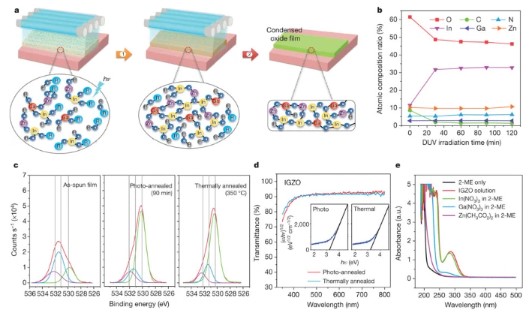Flexible metal-oxide devices made by roomtemperature photochemical activation of sol–gel films
- 저자
- Yong-Hoon Kim, Jae-Sang Heo, Tae-Hyeong Kim, Sungjun Park, Myung-Han Yoon, Jiwan Kim, Min Suk Oh, Gi-Ra Yi, Yong-Young Noh and Sung Kyu Park*
- 저널명
- Nature, 489, 128–132 (2012)
- 년도
- 2012
- Link
- http://dx.doi.org/10.1038/nature11434 537회 연결
[Abstract]
Amorphous metal-oxide semiconductors have emerged as potential replacements for organic and silicon materials in thin-film electronics. The high carrier mobility in the amorphous state, and excellent large-area uniformity, have extended their applications to active-matrix electronics, including displays, sensor arrays and X-ray detectors. Moreover, their solution processability and optical transparency have opened new horizons for low-cost printable and transparent electronics on plastic substrates. But metal-oxide formation by the sol–gel route requires an annealing step at relatively high temperature, which has prevented the incorporation of these materials with the polymer substrates used in high-performance flexible electronics. Here we report a general method for forming high-performance and operationally stable metal-oxide semiconductors at room temperature, by deep-ultraviolet photochemical activation of sol–gel films. Deep-ultraviolet irradiation induces efficient condensation and densification of oxide semiconducting films by photochemical activation at low temperature. This photochemical activation is applicable to numerous metal-oxide semiconductors, and the performance (in terms of transistor mobility and operational stability) of thin-film transistors fabricated by this route compares favourably with that of thin-film transistors based on thermally annealed materials. The field-effect mobilities of the photo-activated metal-oxide semiconductors are as high as 14 and 7 cm2 V−1 s−1 (with an Al2O3 gate insulator) on glass and polymer substrates, respectively; and seven-stage ring oscillators fabricated on polymer substrates operate with an oscillation frequency of more than 340 kHz, corresponding to a propagation delay of less than 210 nanoseconds per stage.
